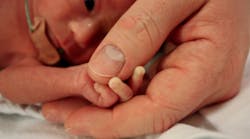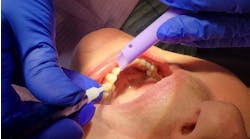November Prematurity Awareness Month: How hygienists can help prep women for pregnancy
By Elicia Lupoli, RDH, BSDH
This year, one of the leading dental companies, Procter & Gamble, is teaming up with the March of Dimes Foundation (MOD) to help champion oral health and premature birth awareness throughout the United States.
November 17, 2016 marks the fifth year that World Prematurity Day (WPD) will be honored globally. P&G and MOD will kick off November Prematurity Awareness Month with the annual United States "birth report card."
If you take no other action, you must at least view your state's report card. The research and data collected will offer much insight on preterm birth rates.
In addition to Crest/Oral-B products, P&G manufactures Pampers, which includes the first diaper specifically developed for babies weighing as little as one pound.
Throughout November Prematurity Awareness Month, the American Association of Women Dentists (AAWD) will also help promote "healthy moms and stronger babies"—the mission of the March of Dimes. These partnerships hope to reach a mass of dental providers and gynecologists from all around the United States to initiate conversations and provide education to women of childbearing ages on the importance of oral health before, during, and after neonatal care. Preconception counseling is imperative from all health-care providers.
The dental hygienist, a licensed clinician and educator in preventive oral health, should assist this campaign during November by spreading this awareness to and beyond our operatories and immediate environments. Dental hygienists need to educate all women on preventing gingival diseases and reducing the modifiable risk factors that continue to be associated with premature births. Up to 70% of women experience gingivitis during pregnancy and by the second trimester, gingivitis is three times more severe than average adult.1
Pregnant patients have morning sickness, (stronger) gag reflex, and may increase their sugar intake.1,2
Dental providers should ask women of childbearing ages what their pregnancy status is, and provide education towards nutrition and weight management (under/over).3
Expecting moms need to be informed to not hold off from dental care by all dental providers and physicians.4 Restorative treatment that is categorized as elective or cosmetic can wait until delivery; however, many patients are not able to disassociate these types of treatments from preventive care. It is all of our jobs to inform women of the difference between prevention and treatment.
Sponsoring or conducting a walk, fundraiser or local campaign with online tools and kits, such as these for youth groups and institutions, can involve offices, providers, and all individuals.
What is a preemie or premature birth?
"Full term" pregnancy is considered to last for 280 days or 40 weeks from the first day of the women's last menstrual period (LMP). Premature or preterm birth is birth before 37 weeks of gestation. Scheduled caesarians or deliveries before 39 weeks can contribute to growth and development deficiencies, and increase the likelihood of future health problems for the baby, dependent on the week of gestation.
The Centers for Disease Control and Prevention (CDC) states that "premature birth is the biggest contributor for infant death (...)”. One in ten babies are born prematurely in the United States and "the premature birth rate in our country is higher than that in most other developed nations."5 While race and ethnicity play a large role in the preterm birth rates, other risks include smoking, diabetes, and chronic high blood pressure.1,6-8
Our conversations about pregnancy
This November, before you order your turkey, think about what this time of year means to you. For me, it has always been family. I look around at the little ones this time of year and give thanks that I practiced hygiene before they were born. I was able to educate my siblings and their spouses on how to care for their children’s oral health before they were even nuggets.
We have to start with the conversation now with soon-to-be or future parents. Once mothers are along in their pregnancy, they have already had bouts of stomach acid and lists of to-do's on their calendar. Stress has kicked in, and, if we haven’t done our job, then a "cleaning" is not important and we missed the best opportunity to promote "healthy moms and stronger babies."
Prevention is the dental hygienist. The best scenario includes reaching all mothers before they are parents.
I’ve had younger clinicians ask me why the patients bleed so much when they’re "healthy." One of my first questions is to ask for the gender. Females have tons of hormones. Whether it’s from birth control pills, maturity, menopause, or menstruation, the fact is women have increased risk of gingivitis at some point in their lives, due to their gender.
No matter when we start the conversation on premature birth, it needs to be started, and there is no better time than during the month of November. Start talking to women and young female adults about this before they get pregnant.
Take a class. Ask employers about bringing up the talk if you are unsure. Ask a local gynecologist to deliver a speech in your community chapter or to go to their office for preventive strategies.
Just as we can go to our local periodontist for calibration, the same rules apply within all health-care settings. This is truly the active definition of an inter-professional collaborative health-care team.
Prevention means reaching these women before the embryo is in the womb. Instead of solely targeting those in the chair with the bump in the belly already, let’s make reducing preemies part of our risk assessment tool.
If you need help identifying with how premature births impact the United States, aside from the obvious, consider that the average medical cost for a healthy baby is $4,389, while the cost for a premature baby is $54,194.5
During this November Prematurity Awareness Month, be on the look out for the purple lights throughout the country to remind you that you too can play in role in this awareness month.
Use your social media accounts to start initiating awareness by going on the WPD Facebook page where you can find images to share and other great resources.
For more information on the partnership between P&G and the March of Dimes, click here. For a list of Prematurity Awareness Month lightings that will shine the purple light in November, click here.
Elicia Lupoli, RDH, BSDH, is a Fones School of Dental Hygiene graduate who recently started to share her success with patients and passion for the industry through writing. She is the owner of a small LinkedIn group called "Dental Mentors" and advocates for mentorship throughout her endeavors. She attributes the start of her writing journey to Shirley Gutkowski, RDH, BSDH after meeting her at CareerFusion 2016. To contact her, send an email to [email protected].






